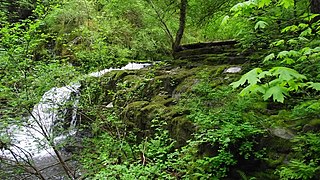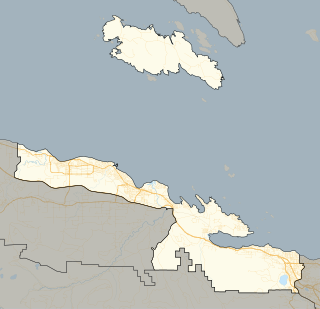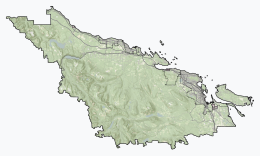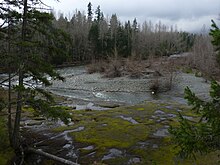
Parksville is a city on Vancouver Island in British Columbia, Canada. As of the 2021 Census, Parksville's population was 13,642, representing a 9.5% increase over the 2016 Census.

Qualicum Beach is a town located on Vancouver Island, British Columbia, Canada. In the 2021 census, it had a population of 9,303. It is situated at the foot of Mount Arrowsmith, along the Strait of Georgia on Vancouver Island's northeastern coast.

The Regional District of Nanaimo is a regional district located on the eastern coast of Vancouver Island, British Columbia, Canada. It is bordered to the south by the Cowichan Valley Regional District, to the west by the Alberni-Clayoquot Regional District, and to the northwest by the Comox Valley Regional District. Its administration offices are located in Nanaimo. During the 2016 census, its population was established at 155,698.
Nanoose Bay is a community on the east coast of southern Vancouver Island, British Columbia, Canada. The location off BC Highway 19 is by road about 26 kilometres (16 mi) north of Nanaimo, and 16 kilometres (10 mi) south of Parksville.

Errington is a small community on Vancouver Island, British Columbia, Canada, located on Errington Road, off Highway 4, just south of Parksville and Qualicum Beach.

Parksville-Qualicum is the name of a provincial electoral district in the Canadian province of British Columbia. It was first contested in the 1991 election. Following redistribution, the area became part of the Nanaimo-Parksville and Alberni-Qualicum ridings. It was again contested in the 2009 general election, and was won by Liberal, Ron Cantelon. The riding consists of the city of Parksville, the town of Qualicum Beach and the communities of Lantzville and Nanoose Bay.

Scott Kenneth Fraser is a Canadian politician who represented the Mid Island-Pacific Rim electoral district in the Legislative Assembly of British Columbia from 2005 to 2020. A member of the British Columbia New Democratic Party, he was first elected as a Member of the Legislative Assembly (MLA) in the 2005 election, defeating one-term Liberal Party incumbent Gillian Trumper, and re-elected in the 2009, 2013 and 2017 elections. During the 41st Parliament (2017-2020) he served in the Executive Council as the Minister of Indigenous Relations and Reconciliation. In that role he led the government through adopting the Declaration on the Rights of Indigenous Peoples Act, with all party support, to implement the United Nations' Declaration on the Rights of Indigenous Peoples (UNDRIP).
Oceanside is a name adopted for a group of communities on the eastern coast of Vancouver Island in British Columbia, Canada. It is part of the Regional District of Nanaimo and includes the City of Parksville and the Town of Qualicum Beach as well as the unincorporated communities of Nanoose Bay, Coombs, Errington, French Creek, Bowser, Deep Bay, Qualicum Bay and a few other smaller centres. The area is promoted by Parksville Qualicum Beach Tourism Association.
Qualicum College was a former private school located in Qualicum Beach, Canada. The school was founded in 1935 and closed in 1970. It was demolished in 2021.

Michelle Stilwell is a Canadian athlete and politician. She represented Canada at four Summer Paralympic Games, as well as the 2015 Parapan American Games. She competed in wheelchair basketball before becoming a wheelchair racer, and is the only female Paralympic athlete to win gold medals in two separate summer sport events.

Mount Seymour Provincial Park is a park in Vancouver, British Columbia's North Shore Mountains. With an area of 35 square kilometres, it is located approximately 15 kilometres north of Downtown Vancouver. The park, named after Frederick Seymour, was established in 1936. Mount Seymour Provincial Park provides visitors with a variety of recreational activities and animals with natural habitat.
Vaseux-Bighorn National Wildlife Area is a National Wildlife Area in British Columbia, Canada, primarily set aside to protect winter rangeland for California bighorn sheep. In 1979, the Vaseux-Bighorn Wildlife Area was established in response to substantial reduction in wild animal populations in the area. Identified factors contributing to species decline at the time were high predator population, overharvesting of species, and illegal hunting. Land development, cattle raising, and lumbering also might have altered species populations. Under these conditions, the area was able to be classified as a Category IV area by the IUCN and is now used for wildlife habitat and conservation. Even with minimal anthropogenic use of the area, threats persist through invasive species. Recreational use is limited spatially and is only open to the public during the day.
Widgeon Valley National Wildlife Area is a National Wildlife Area located near the south end of Pitt Lake in British Columbia, Canada. The property was purchased by the Nature Trust of British Columbia in 1973 and declared a National Wildlife Area by the Canadian Wildlife Service in October of that year. The Widgeon Valley National Wildlife Area is a biologically diverse marsh wetland. It is the traditional territory of various First Nations groups. The Widgeon Valley Wildlife Area is a protected wildlife area that is home to a number of sensitive waterfowl and fish species. The public uses the channels through the Widgeon Valley National Wildlife Area for recreational canoeing, anywhere else within the protected area is strictly off-limits to the public. There are future plans to develop interpretive trails through the park and open it to the public.
Located in the southern part of British Columbia, Columbia National Wildlife Area was established to protect its wetlands and as a temporary home for migratory birds travelling to South America. The National Wildlife Area (NWA) is divided into four unit areas: Wilmer, Spillimacheen, Brisco and Harrogate, which are home to many diverse species of animals and plants which are significant in Canada.
Baynes soil series is an imperfectly drained soil which occurs on eastern Vancouver Island and the adjacent Gulf Islands. Its parent material is eolian, fluvial or marine sand. The soil texture is usually loamy sand or sandy loam, but pure sand horizons may also be encountered. It is classified as Gleyed Dystric Brunisol or Gleyed Humo-Ferric Podzol.

Mount Arrowsmith Biosphere Region (MABR) is a UNESCO Biosphere Reserve located on the east coast of Vancouver Island in British Columbia, Canada. It was designated in 2000 by UNESCO to protect a large second-growth coast Douglas fir ecosystem in the watersheds of the Little Qualicum and Englishman Rivers from being developed.

White Lake Grasslands Protected Area is a conservation site located in the Regional District of Okanagan-Similkameen of British Columbia, Canada. It was established on April 18, 2001 by an order-in-council under the Environment and Land Use Act to protect the semi-arid grassland and pine forest ecosystem west of Vaseux Lake.

Adam Walker is a Canadian politician who was elected to the Legislative Assembly of British Columbia in the 2020 British Columbia general election. He represents the electoral district of Parksville-Qualicum as an Independent.
Scott Islands Marine National Wildlife Area is a National Wildlife Area off the northwestern tip of Vancouver Island in the Canadian province of British Columbia. Covering an area of 11,570.65 km2 (4,467.45 sq mi), it is the second largest protected area in British Columbia after Offshore Pacific Seamounts and Vents Closure and is the largest national wildlife area in Canada.














